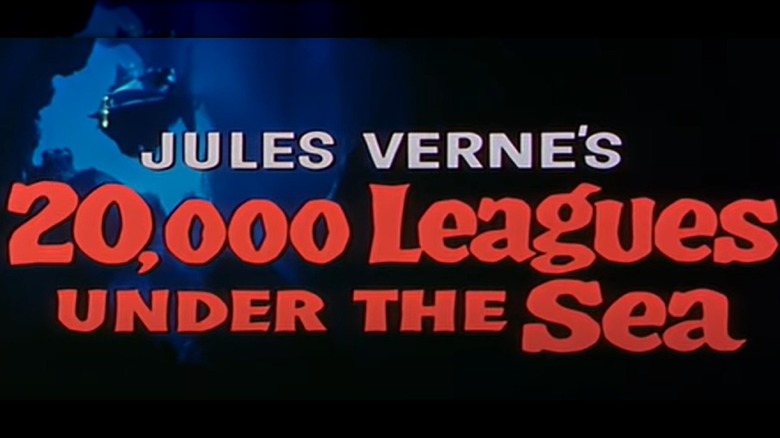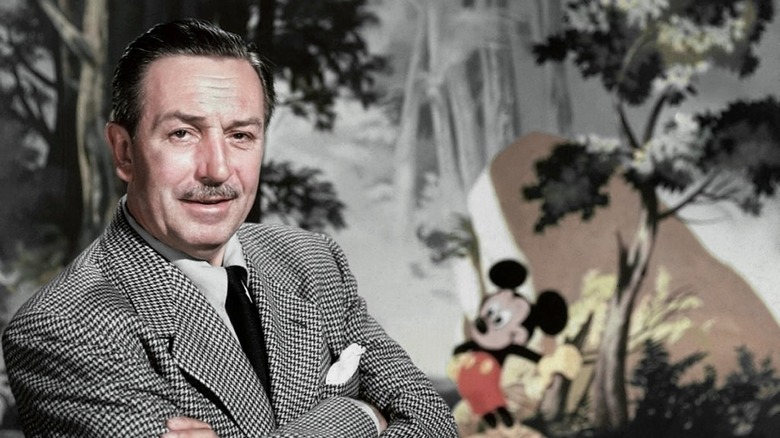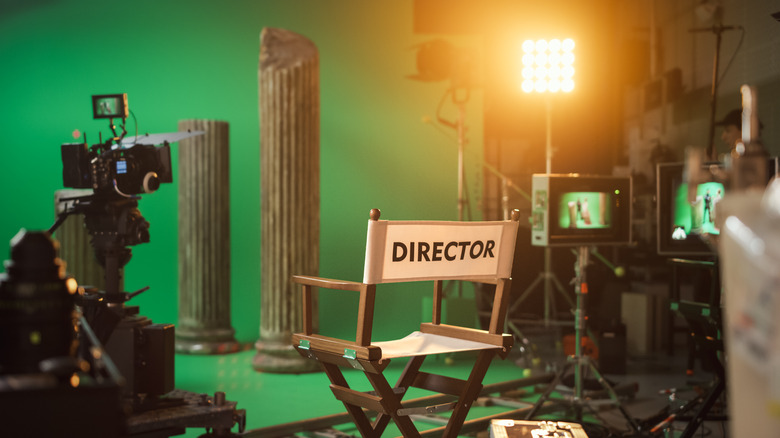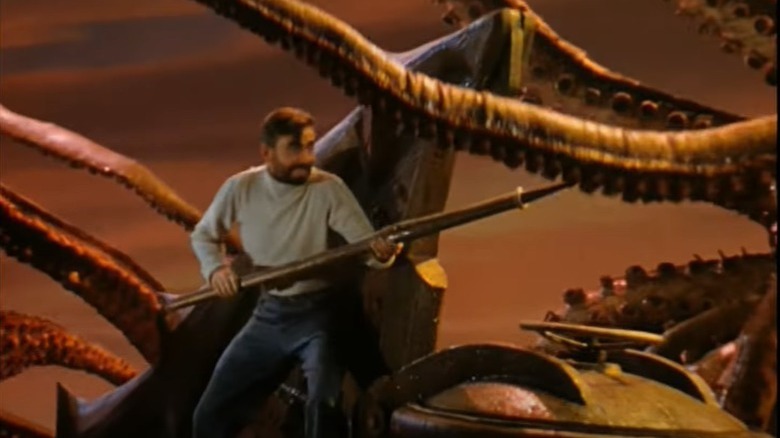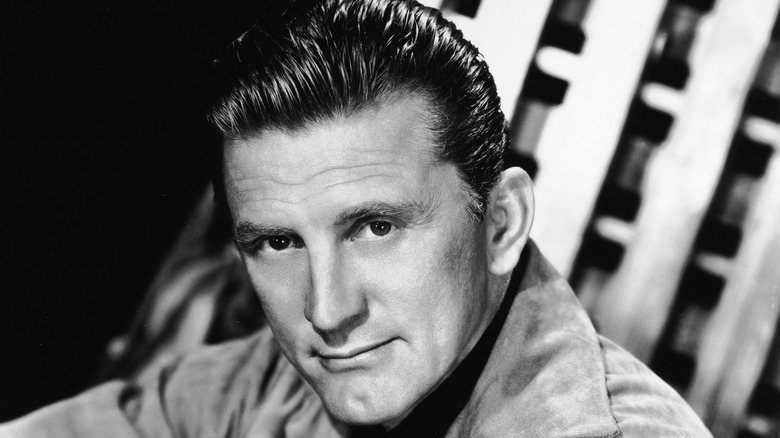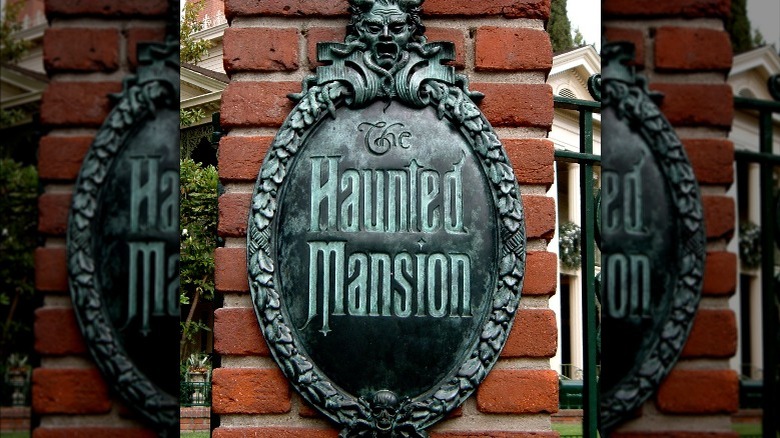The Untold Truth Of 20,000 Leagues Under The Sea
The 1954 film "20,000 Leagues Under the Sea" was an adaptation of the classic novel of the same name written by French novelist Jules Verne and published in 1870. The story is told in Professor Pierre Aronnax's words, as he conducts an investigation on the series of attacks believed to be carried out by a sea monster. It turns out the monster was a submarine — the Nautilus — manned by Captain Nemo. The men embark on an underwater adventure full of twists and turns that leave readers guessing (via Britannica).
"20,000 Leagues Under the Sea" starred Paul Lukas, Peter Lorre, Kirk Douglas, and James Mason. The film was shot on a $5 million budget and it racked $28 million in domestic box office sales, as reported by The Numbers. It also did well in the 1955 Academy Awards, garnering three nominations and winning two — Best Special Effects and Best Art Direction, per Walt Disney Archives. Here are some interesting facts about the science fiction movie.
The adaptation was supposed to be animated
Walt Disney originally wanted the "20,000 Leagues Under the Sea" adaptation to be an animated feature film, according to Classic Movie Hub. However, the film producer was convinced to do a live-action version instead after seeing the pre-production sketches created by artist Harper Goff, who served as the Art Director for the movie.
Goff thought hard about how to bring Jules Verne's words to life. "In motion pictures, the text of a classic like this subject is sacrosanct like the Bible! The 'word' of Jules Verne is not to be made light of, so the duty of the production designer like myself is to take the sometimes arbitrary descriptions of the Nautilus as recorded by 'J.V.' and 'make it work'," he said (via Flashback). It goes without saying that Disney was impressed with Goff's work, so he agreed that "20,000 Leagues Under the Sea" should be made into a live-action movie instead.
A made-for-TV animated movie of the novel was released in 1985, which was created by Burbank Films Australia, but it never became as widely popular as the 1954 live-action version.
The son of Disney's rival directed the movie
The Fleischer brothers were considered Walt Disney's main competitors in the 1930s. Fleischer Studios was responsible for producing cartoons that featured characters such as Popeye the Sailor and Betty Boop. For that reason, it was a surprise that Disney selected Richard Fleischer — the son of Max Fleischer — to direct "20,000 Leagues Under the Sea."
According to Fleischer, he was shocked when he received a call from Disney himself, requesting that he direct the movie. His response was, "You do know who I am?" Disney was aware that he was the son of his rival, but nevertheless, he saw him as the perfect person to do the job, according to the Los Angeles Times. Richard wanted to get his father's blessing before taking Disney's offer. Max saw the huge opportunity being offered to his son, so he gave Richard the go-ahead to work for his rival and said, "Of course you must take that job without any question. Just do one thing. Give a message to Walt for me, tell him that he's got a great taste in directors" (via Walt Disney Archives).
The giant squid battle was reshot
The giant squid battle with special effects near the end of "20,000 Leagues Under the Sea" turned out great and won the film an Oscar, but the scene was actually reshot. The initial footage was taken during sunset, with the calm waters serving as the background. The gears that controlled the giant squid, as well as the cameras, were seen in the shot too. Both Richard Fleischer and Walt Disney didn't like the way it turned out. It lacked the drama needed for such a climactic scene, and everything looked fake (per IMDb).
Because of the lackluster footage, Disney decided to have the entire scene reshot. It was decided that the giant squid battle was going to take place during a brutal storm to add to the drama. The reshoot delayed production for six weeks, and an additional $200,000 was added to the expenses, as reported by It Came from Blog. The reshoot made a huge difference and despite the hassle, it was all worth it in the end as it is one of the most memorable scenes in the movie.
Kirk Douglas requested a scene with women and a brawl
The scene in the film where Kirk Douglas — who played the role of Ned Land — walked in with two women by his side and the brawl that happened afterward wasn't in the script. In fact, it was Douglas himself who requested the scene to be added. In his book titled "The Ragman's Son," Douglas shared his reasoning.
"20,000 Leagues Under the Sea" was shot in the early 1950s, and at that time, Douglas was at the peak of his career. His typical roles in Hollywood painted him as a hero-type macho man who impressed the ladies. In the script, however, Douglas didn't have a single interaction with a woman, and there were no fight scenes that involved him as well. The actor wanted to preserve his macho persona, so he suggested the scene to both Walt Disney and director Richard Fleischer. The two agreed, and the scene was incorporated into the shooting, as reported by Classic Movie Hub.
Captain Nemo's pipe organ is in Disneyland's Haunted Mansion
"20,000 Leagues Under the Sea" had many interesting props, one of them being Captain Nemo's pipe organ that he played in the movie. With the success of the film, Walt Disney decided that it was a wonderful idea to display some of the sets and props at Disneyland. When the theme park opened in California in 1955, the area called Tomorrowland had the least attractions. It was there where the "20,000 Leagues Under the Sea" exhibit was housed, according to Duchess of Disneyland. Captain Nemo's pipe organ was one of the featured props, and what was supposedly a temporary exhibit stayed for 11 years.
The exhibit was eventually dismantled in 1966, and the props were put in storage. Three years later, the Haunted Mansion opened its doors, and Captain Nemo's pipe organ was used in the ballroom. per Disney Parks Blog. It remained the same in appearance, except for the fanned-out pipes that were replaced with straight ones and the mirror that was replaced with a bat. The organ is still there to this day, and two replicas were created for Magic Kingdom and Tokyo Disneyland's Haunted Mansions.
